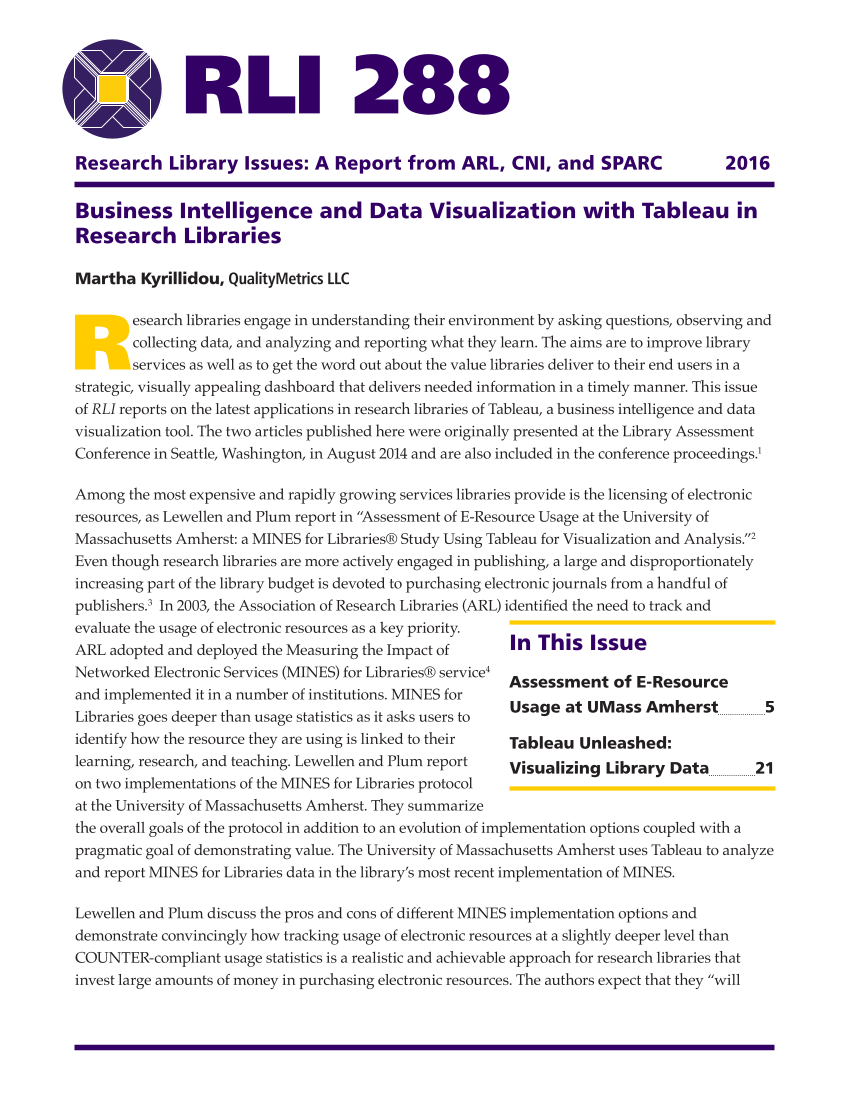RLI 288 Research Library Issues: A Report from ARL, CNI, and SPARC 2016 Business Intelligence and Data Visualization with Tableau in Research Libraries Martha Kyrillidou, QualityMetrics LLC In This Issue Assessment of E-Resource Usage at UMass Amherst 5 Tableau Unleashed: Visualizing Library Data 21 R esearch libraries engage in understanding their environment by asking questions, observing and collecting data, and analyzing and reporting what they learn. The aims are to improve library services as well as to get the word out about the value libraries deliver to their end users in a strategic, visually appealing dashboard that delivers needed information in a timely manner. This issue of RLI reports on the latest applications in research libraries of Tableau, a business intelligence and data visualization tool. The two articles published here were originally presented at the Library Assessment Conference in Seattle, Washington, in August 2014 and are also included in the conference proceedings.1 Among the most expensive and rapidly growing services libraries provide is the licensing of electronic resources, as Lewellen and Plum report in “Assessment of E-Resource Usage at the University of Massachusetts Amherst: a MINES for Libraries® Study Using Tableau for Visualization and Analysis.”2 Even though research libraries are more actively engaged in publishing, a large and disproportionately increasing part of the library budget is devoted to purchasing electronic journals from a handful of publishers.3 In 2003, the Association of Research Libraries (ARL) identified the need to track and evaluate the usage of electronic resources as a key priority. ARL adopted and deployed the Measuring the Impact of Networked Electronic Services (MINES) for Libraries® service4 and implemented it in a number of institutions. MINES for Libraries goes deeper than usage statistics as it asks users to identify how the resource they are using is linked to their learning, research, and teaching. Lewellen and Plum report on two implementations of the MINES for Libraries protocol at the University of Massachusetts Amherst. They summarize the overall goals of the protocol in addition to an evolution of implementation options coupled with a pragmatic goal of demonstrating value. The University of Massachusetts Amherst uses Tableau to analyze and report MINES for Libraries data in the library’s most recent implementation of MINES. Lewellen and Plum discuss the pros and cons of different MINES implementation options and demonstrate convincingly how tracking usage of electronic resources at a slightly deeper level than COUNTER-compliant usage statistics is a realistic and achievable approach for research libraries that invest large amounts of money in purchasing electronic resources. The authors expect that they “will





































